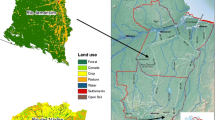Abstract
This paper presents results of analysis of land use changes in Nigeria, using the integrated bio-economic spatial model. Land use change is currently gaining global attention of researchers and policy makers, given the social, economic and environmental implications of land use and landscape changes. Understanding current land use situation and changes and projecting likely effects of current land use is important for sustainable development. Data for this study include social, economic, soil, crop production, vegetative and other relevant data. The data came from both primary and secondary sources. Data were also sourced from expert knowledge. Spatial maps of soil characteristics, land use patterns, vegetative cover, population density and rainfall patterns were produced. The maps show wide variations in spatial characteristics of the variables considered across the state. The results of gross margin analysis indicate that some particular crop combinations show better economic prospect than others. While the results from the study so far have been revealing, the analysis is still inconclusive, given that this is a progress report. The next phase of the study is to analyse the ecologic implications of current land use (or farming systems) in the study area and examine the trade-off between economic and ecologic factors.
A Paper prepared for Presentation at the “International Conference on Environment: Survival and Sustainability”, Nicosia-Northern Cyprus, 2007
Access this chapter
Tax calculation will be finalised at checkout
Purchases are for personal use only
Similar content being viewed by others
References
Ajibefun IA, Wenkel K-O, Wieland R, Mirschel W (2004) Modelling of landscape and land use changes: with application of spatial analysis modelling tool to quillow region of north east Germany. Int J Food, Agric Environ Finland 2(2):364–368
Anderson JR, Dillon JL, Hardaker JB (1977) Agricultural decision analysis. Iowa State University Press, Ames
Armstrong AC, Legros JP, Voltz M (1996) A detailed model for crop growth and water condition. Int Agrophys (10):171–184
Bouman BAM, Nieuwenhuyse A, Hengsdijk H, (1998) PASTOR: A technical coefficient generator for pasture and livestock systems in the humid tropics. Version 2.0. A users guide. Quantitative approaches in systems analysis, No. 18. AB-DLO-PE, Wageningen, The Netherlands
Hengsdijk H, Nieuwenhuyse A, Bouman BAM (1998) LUCTOR: Land use crop technical coefficient generator. A model to quantify cropping systems in the Northern Atlantic Zone of Costa Rica, Version 2.0. QUASA series no. 17, ABDLO/PEW, Wageningen, The Netherlands
Krugman P (1995) Development, Geography and Economic theory. MIT Press, Cambridge, MA
Loveland PJ, Rounse vell MDA, Mayr TR, Legros JP, Voltz M, de la Rosa D, Armstrong AC (1993) Agroclimatic Change and European Soil Suitability- a spatially distributed model. In: Troen I (ed) Climate change and impacts. European Union publication 15921 EN, pp 215–228 Copenhagen, Denmark
Mirschel W, Wieland R, Voss M, Ajibefun I, Deumlich D (2006) Spatial analysis and modelling tool (SAMT) 2: Applications. Ecological informatics, vol. 1. Elsevier Science, United Kingdom, pp 77–85
Rounsevell MDA, Evans SP, Mayr TR, Andsley E (2001) Integrating biophysical and socio-economic model for land use studies soil survey and land research centre. Cranfield University Silsoe
Van Keulen H, Veeneklaas FR (1993) Options for Agricultural development: A case study of Mali’s fifth region. In: Penning de vries FWT, Teng P, Metselaar K (eds), System approaches for agricultural development. Proceedings of the International Symposium on Systems Approaches for Agricultural Development, Bangkok, Thailand. Kluwer Academic Publishers, Dordrecht, Netherlands, pp 369–382
Wieland R, Voss M, Holtman X, Mirschel W, Ajibefun I (2006) Spatial analysis and modelling tool (SAMT) 1: Structure and possibilities. Ecological informatics, vol 1. Elsevier Science, United Kingdom, pp 67–76
Wieland R, Mirschel W, Wenkel K-O, Ajibefun I (2004) Spatial simulation with SAMT. In: Wittmann J, Wieland R (eds) Simulation in environment and geosciences. Shaker Verlag, Aachen, Germany, pp 161–181
Wischmeier W, Smith DD (1978) Predicting rainfall erosion losses: A guide to conservation planing. Agricultural handbook No 537. Washington, DC, USDA
Zander P (2003) Agricultural land use and conservation options: A modelling approach, Thesis Landbouwuniversiteit Wageningen, 222pp
Acknowledgement
Thanks are due to the Alexander von Humboldt Foundation of Germany for providing funding for this research under the “Return Fellowship Programme”.
Author information
Authors and Affiliations
Corresponding author
Editor information
Editors and Affiliations
Rights and permissions
Copyright information
© 2010 Springer-Verlag Berlin Heidelberg
About this chapter
Cite this chapter
Ajibefun, I.A. (2010). Analysis of Land Use Changes in Nigeria: With Application of Integrated Bio-economic Spatial Model. In: Gökçekus, H., Türker, U., LaMoreaux, J. (eds) Survival and Sustainability. Environmental Earth Sciences. Springer, Berlin, Heidelberg. https://doi.org/10.1007/978-3-540-95991-5_31
Download citation
DOI: https://doi.org/10.1007/978-3-540-95991-5_31
Published:
Publisher Name: Springer, Berlin, Heidelberg
Print ISBN: 978-3-540-95990-8
Online ISBN: 978-3-540-95991-5
eBook Packages: Earth and Environmental ScienceEarth and Environmental Science (R0)




